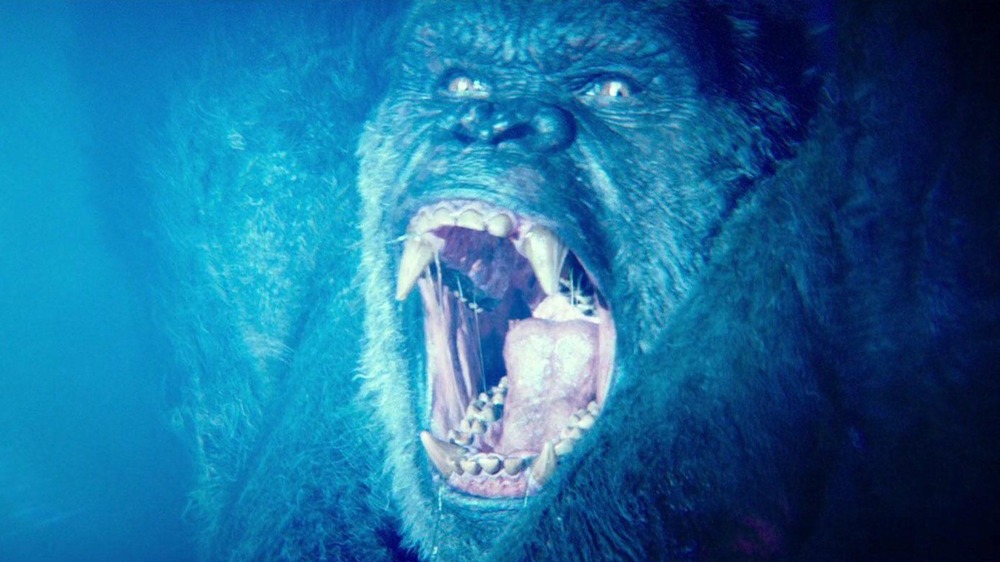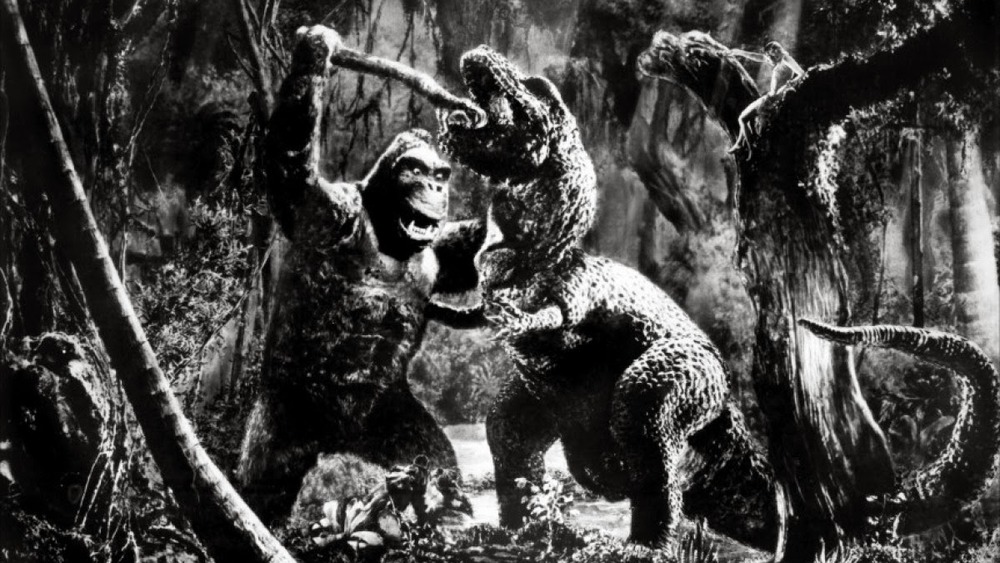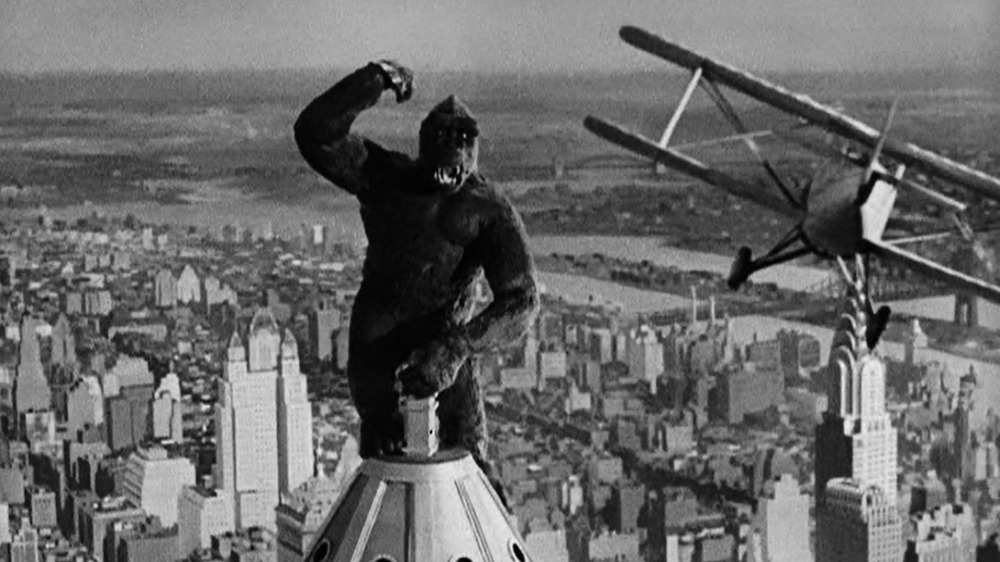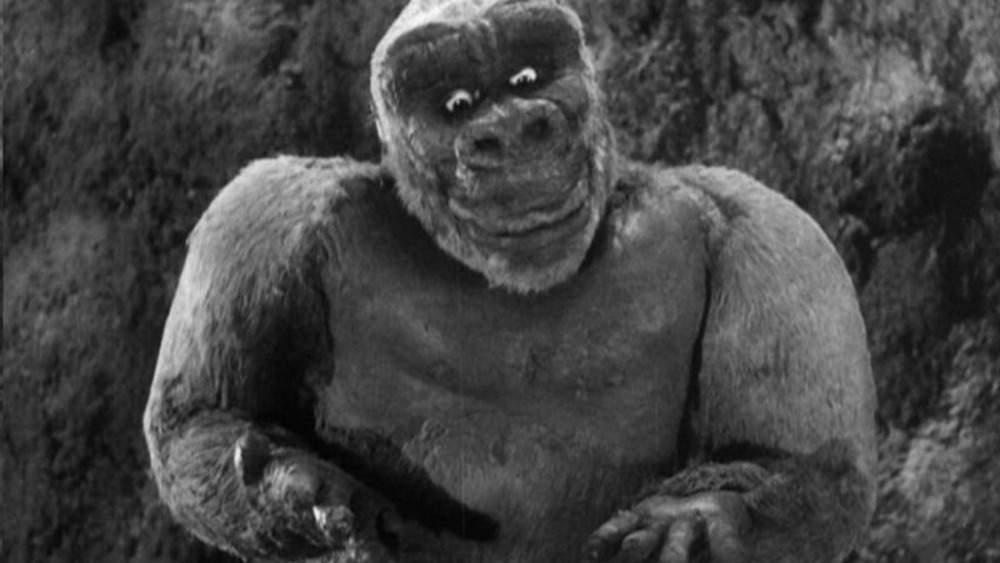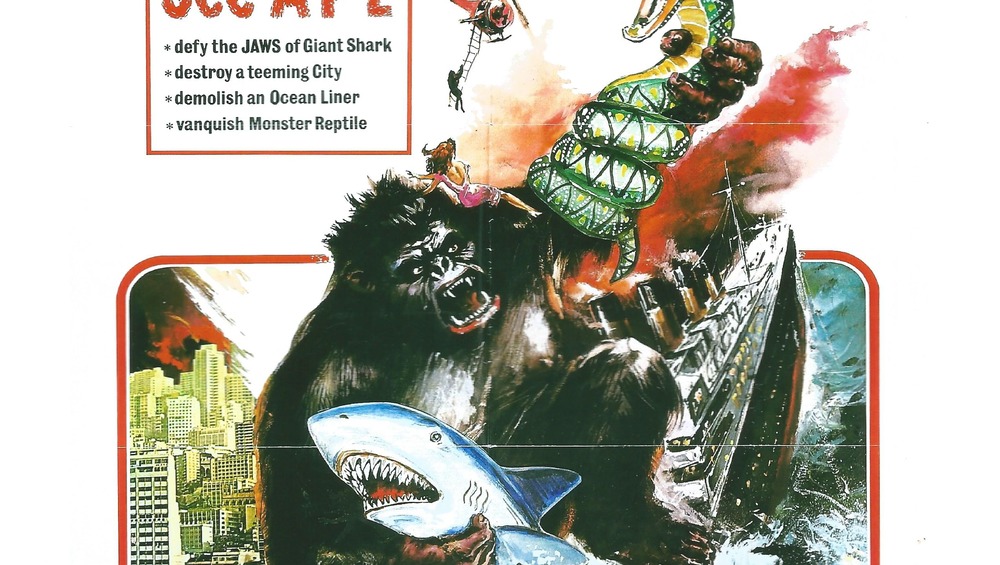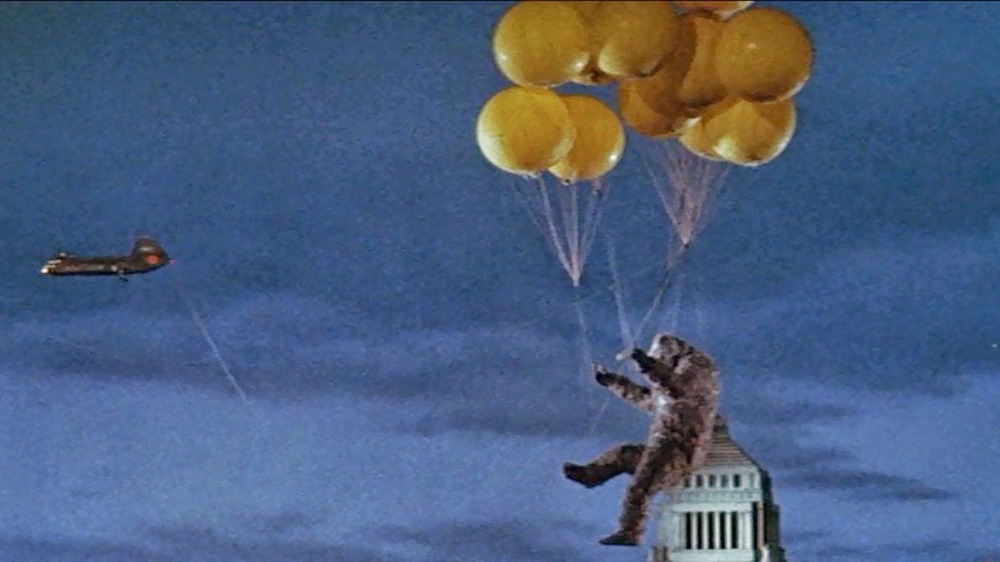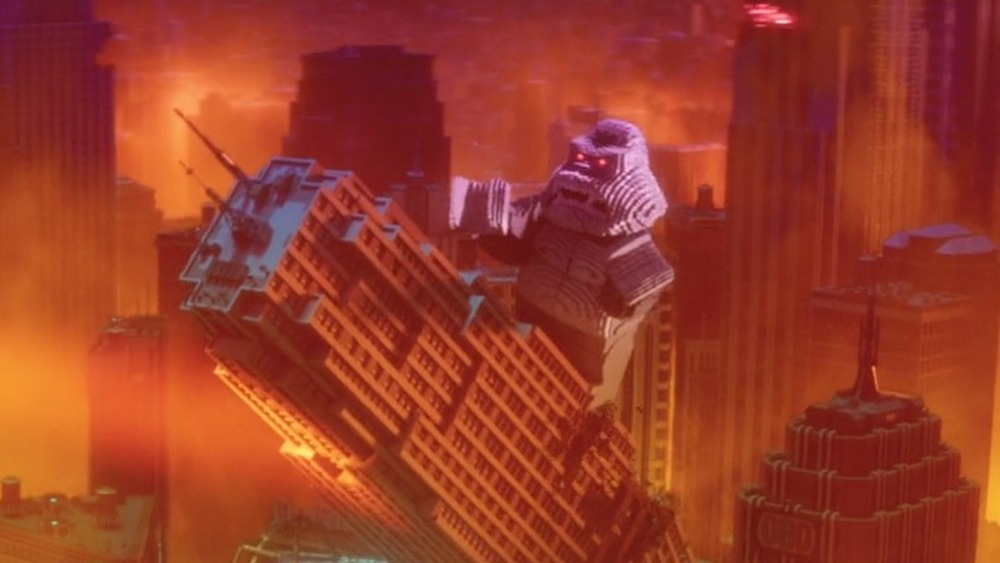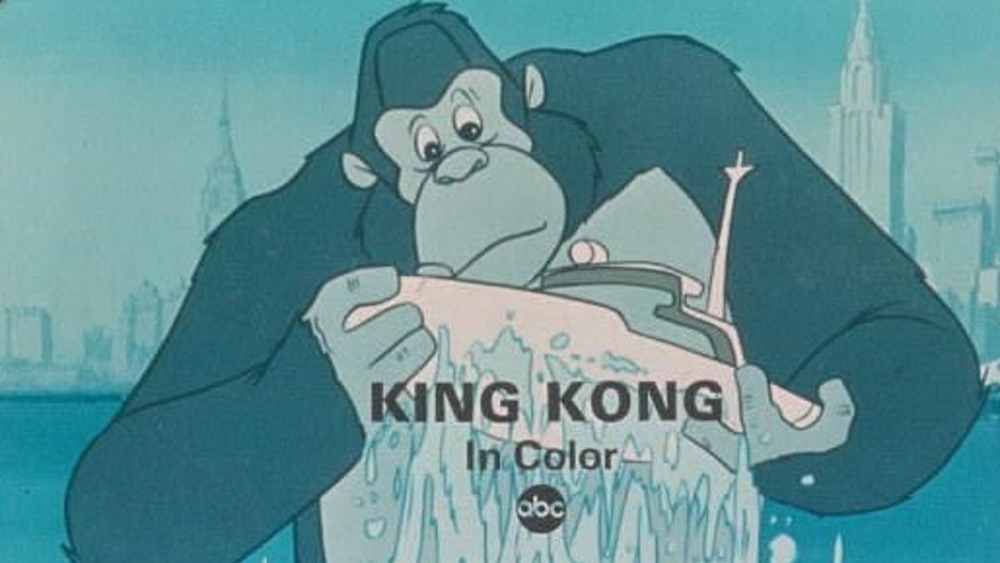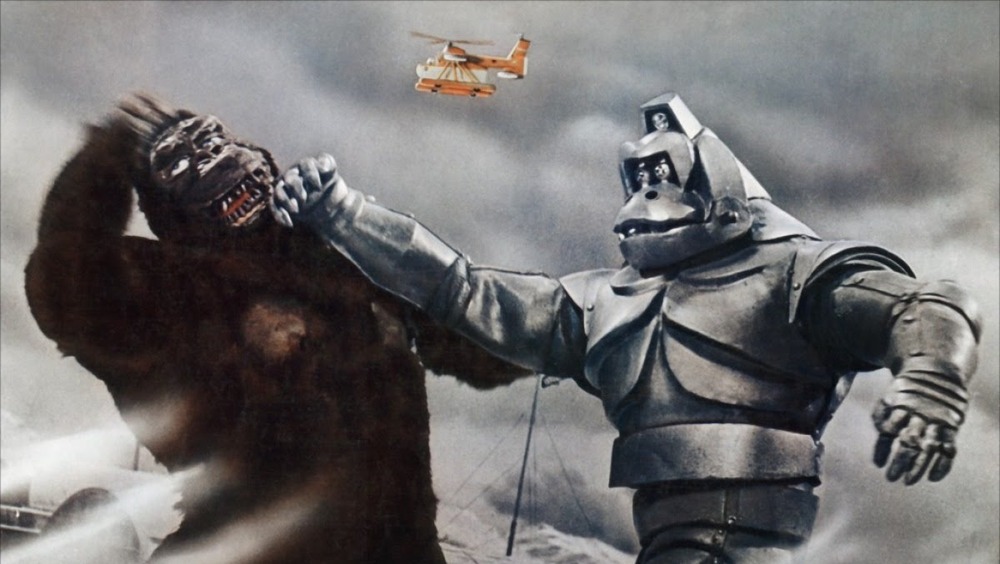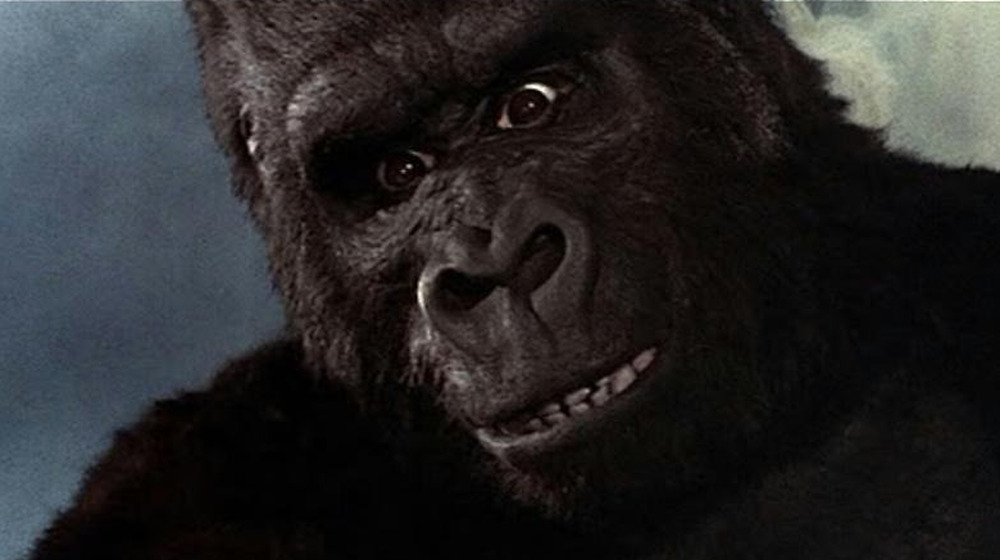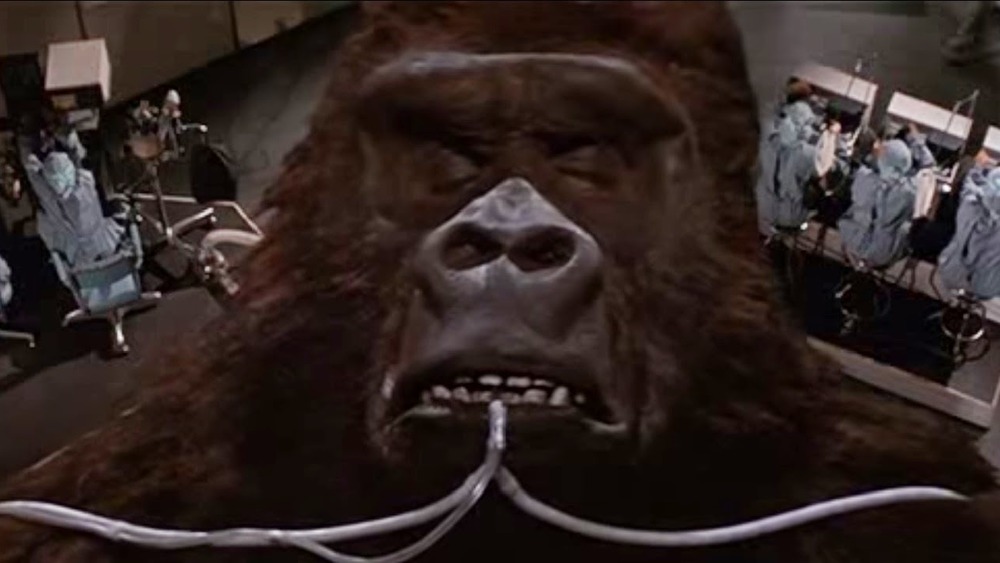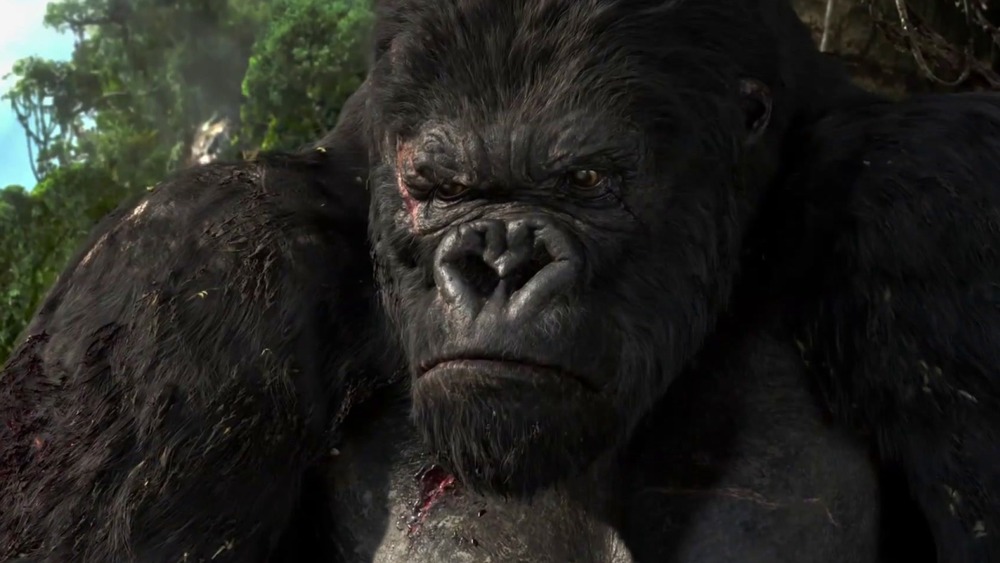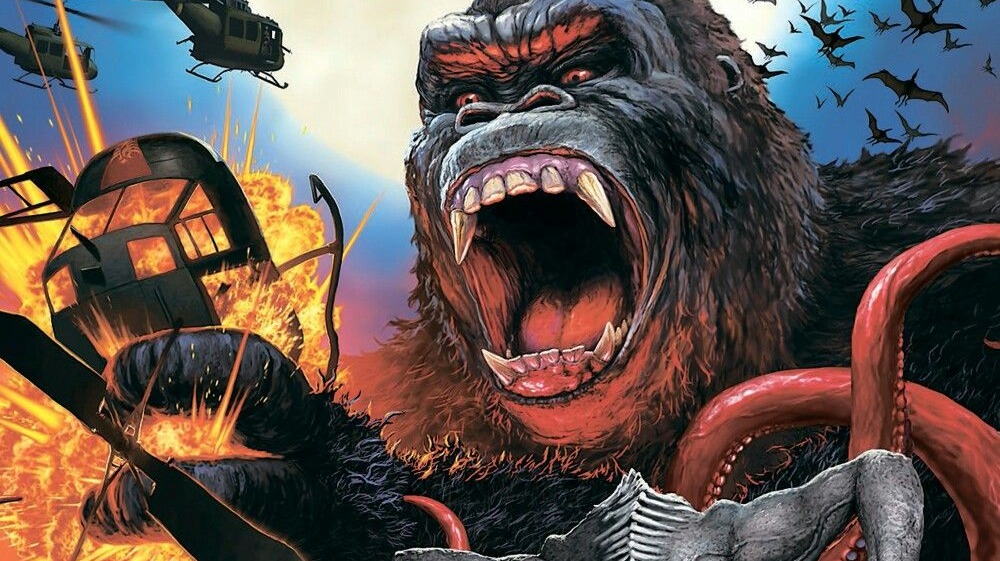The History Of King Kong Explained
People often say our current superhero movies are modern-day mythology, but nothing to come out of Hollywood deserves that title quite like King Kong.The story of the giant ape stolen from his unspoiled island home hits audiences at the deep, primal level of the great myths. It's as thematically rich as any of them — it could be a simple Beauty and the Beast story, as the dialogue claims, or it could be a story of untamed masculine aggression and desire, of environmental destruction, of indigenous life doomed by the march of western civilization, of an inscrutable, wrathful god reduced to mortality. The story of King Kong has been subject to multiple retellings and reinterpretations — as a stop-motion model, a man in a suit, a man in a motion-capture suit, and most recently, the challenger in a blockbuster rematch with the other greatest movie monster of all time, Godzilla.
How did we get here? King Kong may be spry for his age, but he's lived a long time, over 90 years from his birth in the mind of Merian C. Cooper to the release of Godzilla vs. Kong. And he's stayed busy all that time, living a long and complicated life we've distilled for you here.
King Kong's creation
Many hands brought King Kong to life, but it all began with Merian C. Cooper. As outlandish as the movie's story of lost islands and daring adventures may seem, it's not too far from Cooper's own life. In Kong: The History of a Movie Icon from Fay Wray to Peter Jackson, Ray Morton chronicles the director's career in what Cooper called "natural dramas," documentaries filmed all over the world, then reshot and recut into narrative form. Even the seemingly inexplicable presence of a movie starlet on a documentary shoot came from real life — screenwriter Ruth Rose based the fictional filmmaker Carl Denham's monologue about how every critic and exhibitor demands a love story on Cooper's own complaints.
The discovery of the Komodo dragon, a huge, primitive reptile that had long been thought extinct, fired Cooper's imagination. He conceived a new natural drama about a war between komodo dragons and a clan of gorillas, eventually whittled down to just one great ape. When Cooper learned the dragons he'd shipped over from Komodo died in captivity, he found his tragic ending.
Cooper commissioned a script from mystery writer Edgar Wallace about a big game hunter who meets a rowboat full of escaped convicts on a lost island. James A. Creelman rewrote it, replacing the hunter with a Cooper-esque filmmaker.
But their studio, RKO, balked at the cost of filming live animals in their natural habitats. Fortunately, they were also filming a never-finished movie called Creation, featuring stop-motion dinosaurs created by the great Willis O'Brien, and Cooper found the man to bring his Kong to life.
The original Kong
In its final form, the original King Kong tells the story of Carl Denham (Robert Armstrong), a filmmaker who journeys to a mysterious island to document the legends of a godlike ape, with down-on-her-luck actress Ann Darrow (Fay Wray) in tow. On landing, they interrupt a sacrifice to Kong, and Ann finds herself on the altar. Denham's crew fights their way across the island and its prehistoric beasts, finally bringing Kong back to New York. He escapes, of course, and drags Ann up the newly built Empire State Building (then the tallest building on earth), until a fleet of fighter pilots shoots him down.
Co-director Ernest Shoedshack was horrified to discover he could see the ways Willis O'Brien's team disturbed Kong's hair as it jumped around between frames. Morton wrote that he "thought the whole project was sunk" until an RKO executive enthusiastically responded, "Look! Kong is angry — his fur is bristling!"
It's the ultimate problematic fave. The inhabitants of Skull Island are hideously stereotyped, and even Kong himself draws parallels to racist fears of apelike Black men stealing white women. But despite this and all its other faults, it still retains a primal power no other movie can compare to. As much as Cooper and O'Brien, the credit goes to Max Steiner for his pulse-pounding music. But RKO were too cheap to commission a score and only paid Steiner to patch together existing music. Cooper paid him out of pocket for an original composition — money well spent.
Son of Kong
King Kong was a monster hit. Even at the height of the Great Depression, it raked in more than $2 million — which may not sound like much after 90 years of inflation, but it adds up to over $40 million in 2021 dollars. RKO was going to milk this cash cow for all it was worth, and that meant rushing a sequel into production — just nine months from pitch to release.
Son of Kong is a lot better than you'd expect under the circumstances — it can't live up to the original (what can?) but it's not bad, or even mediocre. Cooper and Rose came up with a surprisingly realistic take on the aftermath of Kong's rampage, with Carl Denham confined to his apartment avoiding lawsuits and court summons. Then again, they also seem to expect us to feel more sorry for Denham than the hundreds of people who died as an all-but-direct result of his actions.
Denham flees the country, where he finds a fugitive who tricks him into helping him escape by claiming there's a treasure on Skull Island (improbably, there really is one) and with the movie already half over, they're off.
On Skull Island, they finally meet and befriend the titular Son of Kong, a smaller, lighter colored baby ape. Then the movie ends with the whole island falling apart right out of nowhere, and Li'l Kong sacrifices himself to save Denham.
King Kong copies
RKO rushed out Son of Kong to beat any knockoffs to market, but that didn't stop them from coming out later. Mighty Joe Young at least has pedigree, with Shoedshack directing, a starring role for Armstrong, a Cooper/Rose script, and animation by Willis O'Brien and his young protegé Ray Harryhausen, who'd soon become Hollywood's go-to stop-motion man.
Konga, meanwhile, was a cheapie knockoff with next to no pedigree, about a chimp who a growth serum turns first into a killer gorilla and then into a Kong-size monster. You could say the same about the cash-ins that followed news of the 1976 remake. Legendary producers the Shaw Brothers took a break from kung fu to produce a Hong Kong King Kong with The Mighty Peking Man. In South Korea, a studio out of Denver, Colorado threw together A*P*E. And if you don't believe it's a ripoff, just know they originally wanted to call it The New King Kong, but sadly didn't go with their second choice, Attack of the Giant Horny Gorilla. It at least has one thing no official Kong movie has — we doubt the Eighth Wonder of the World ever flipped anyone the bird.
Beyond the movies, we have Hanna-Barbera's plus-sized cartoon star Grape Ape, Superman's Titano the Super-Ape, a chimp named Toto who goes monster-size thanks to kryptonite, and Rampage, the video game that was later adapted into a movie starring Dwayne Johnson. And we can't forget Donkey Kong, the arcade classic that introduced Mario and may have even eclipsed its namesake.
King Kong vs. Godzilla
Even Godzilla himself owes a debt to Kong. He would have been an O'Brien-esque stop-motion creation if money hadn't been tight, and the original Godzilla recreates Kong's elevated train attack. So of course they had to meet eventually. Toho's 30th anniversary was a perfect opportunity — how better to celebrate than to pit the studio's biggest star against his American equivalent?
Godzilla vs. King Kong was only the third Godzilla movie, the first in almost a decade, and, according to Japan's Favorite Mon-star by Steve Ryfle, it ended up deciding the franchise's direction. The original movie had been a deadly serious allegory for atomic war, but kids loved the big lizard anyway, and this new movie was designed to appeal to those young fans.
Thanks to Godzilla's creator Ishiro Honda, there was still social commentary. But this time, that meant a goofy satire of TV advertising with some of Japan's biggest comedy stars, in a story about a drug company that captures Kong to be their mascot and stages a fight between him and Godzilla by carrying him to the arena with giant balloons. Not everyone was happy: Ryfle quotes effects artists who were horrified at some of the goofy things coordinator Eiji Tsubaraya expected them to do.
As for Kong, he's literally big in Japan — he grew from a small enough to comfortably interact with the human characters to Godzilla size. That evened the odds, but also made the obligatory building-climbing scene less dramatic, since the building's now smaller than Kong.
King Kong crossovers
King Kong vs. Godzilla was the Eighth Wonder's biggest crossover. But every kid has probably dreamed of their favorite heroes fighting King Kong, and some of those kids grew up to write about it. In 2013, to commemorate the mutual 80th anniversaries of Kong and the pulp-fiction proto-superhero Doc Savage (who, fittingly, worked out of the Empire State Building), Will Murray and Joe DeVito wrote Doc Savage: Skull Island, in which Savage's hunt for a ship belonging to his ancestor Stormalong Savage leads him to Kong's island.
Somehow, give or take an unauthorized Bollywood movie, it took until 2016 for Kong to meet the other King of the Apes, Tarzan. But Murray and DeVito finally made it happen in their novel King Kong vs. Tarzan, which imagines Kong escaping Denham's ship when it docks in Africa, where his rampage brings Tarzan down on his head.
The two jungle kings might have met sooner if Dark Horse Comics' plans to license King Kong had followed through — in Comics Gone Ape, Michael Eury reveals the publisher's plans to pair the Eighth Wonder not just with Tarzan, but the Rocketeer too.
On the big screen, Seth Green voiced Kong when he joined Jaws, the Wicked Witch of the West, and the rest of the Phantom Zone prisoners to fight the Dark Knight in The LEGO Batman Movie. And Kong appears as one of the pop-culture obstacles in the massive virtual reality game that forms the setting for Ready Player One.
King Kong cartoons
Kong began life as an animated character, so it makes sense he'd make his way back to animation multiple times over the years. Rudolph the Red-Nosed Reindeer creators Rankin-Bass coproduced The King Kong Show with Japanese super-studio Toei in 1966. However you feel about the remakes' imaginings of Kong as a romantic hero, none of them departed from the wild, vicious original quite like this series, in which the Eighth Wonder befriends a little boy named Bobby Bond and travels the world fighting evil.
But that's nothing next to The Mighty Kong. Released straight to video in 1998, this is a Disney-style animated musical with songs by Disney's own Sherman Brothers and starring the Little Mermaid herself, Jodi Benson. Kong even survives falling off the Empire State at the end! Or, as Wikipedia puts it, "he slams into the streets of New York and ends up unconscious for a while."
2000's Kong: The Animated Series follows a plot similar to The King Kong Show, with a Kong clone fighting evil alongside a boy named Jason Jenkins, who can merge with him thanks to a "Cyber-Link." It only lasted two seasons, but the success of the 2005 remake inspired two DVD movies, Kong: King of Atlantis and Return to the Jungle.
Finally, Netflix got in on the act with Kong: King of the Apes, in which Kong goes back to his roots fighting dinosaurs — this time, robotic ones in the future world of 2050.
King Kong Escapes
King Kong vs. Godzilla did so well for Toho they decided to create a whole series of homegrown Kong flicks. Unfortunately, they created a new, improved suit and wrote a full script for King Kong vs. Ebirah before talking to the Eighth Wonder's American handlers, who answered with a flat no. Ebirah was recycled as a Godzilla movie with the un-Godzilla-like human-monster romance intact, but the suit would have to wait until Toho worked out a better deal.
That finally happened thanks to Rankin-Bass, which coproduced a new movie based loosely on The King Kong Show. King Kong Escapes carried over the cartoon villains Dr. Who (no relation) and Mechanikong, this time plotting to tap an arctic deposit of the radioactive Element X and sell it to an unnamed foreign power represented by Madame Piranha. Escapes also threw in a classic Kong vs. dinosaurs battle, introducing Gorosaurus, who'd join the all-star cast of creatures in Destroy All Monsters and become a fixture of Godzilla comics and games. And if Mechanikong looks familiar, it appeared on The Muppet Show of all places, where its head was repurposed as Dr. Bunsen's gorilla detector.
When Toho revived Godzilla in the '80s, they hoped to stage a rematch between King Kong and the King of the Monsters. By this time, RKO was out of business and Kong belonged to Universal, who were no more accommodating. The Japanese studio contemplated working around Universal's objections by using Mechanikong instead before wisely deciding not to risk it.
Dino DeLaurentiis' Kong
King Kong returned to stateside screens in 1976 thanks to Italian superproducer Dino De Laurentiis and a script by Lorenzo Semple Jr., creator of TV's Batman. After the runaway success of Jaws, monsters were big business, and both De Laurentiis and Universal made their own deals with RKO for the rights to the big ape, starting a tug-of-war that lasted for years.
When it ended, De Laurentiis released a King Kong for the '70s in which Carl Denham is replaced with a scummy oil executive (Charles Grodin) who wants to exploit Skull Island's mineral resources. Instead of the Empire State Building, Kong climbs the World Trade Center. Jeff Bridges plays a hippie scientist.
That's special effects legend Rick Baker in the ape suit, but he wasn't too happy with the final product. He may have been thinking of the scene when Kong bathes Ann in what looks like a mini-golf water feature and then blows her dry, his cheeks inflating like big, rubbery balloons while Ann writhes orgasmically. The crew had some even odder effects ideas to cut costs — at one point, they considered casting a little person as Kong so they could build even more miniature miniatures.
King Kong Lives
The 1976 King Kong is often remembered as a flop since it failed in its stated goal of outperforming Jaws, but by any other standards, it was a huge hit, making back triple its cost. Even knowing that, it's hard to imagine anyone was clamoring for a sequel exactly ten years and two days later, but that's when King Kong Lives debuted. How does King Kong live, exactly? Because a university has kept him on life support all this time and revived him with a ginormous artificial heart, apparently. But he's still lost the will to live, so the scientists bring him a newly discovered female Kong to jolt him awake. By the end, there's even a little (relatively speaking) baby Kong too!
Dino De Laurentiis explained his rationale to American Cinematographer: "Steve McQueen made a picture in which he died at the end, but they made another picture with Steve McQueen. Many stars die at the end of a picture and then go on to the next picture. Kong is a star. We are going to have a new story, a new Kong."
Over in Fangoria, screenwriter Ron Shusset discussed the many other possibilities De Laurentiis considered, which makes the plot they finally went with look downright realistic: "They had King Kong in Russia and King Kong in outer space. Really, this is not an exaggeration."
Peter Jackson's Kong
Lord of the Rings director Peter Jackson fell in love with King Kong the moment he saw it on TV as a small child. The 2005 film is actually his second remake — Morton's book reveals Jackson had already recreated it with claymation and a camcorder at age 12.
Universal gave him the chance to mount a more professional remake on the set of his first Hollywood movie, The Frighteners. At first, he found the task too daunting to consider, but he changed his mind out of worry Universal would offer the job to someone else who might do even worse with it. But the project went on hold until he followed up Return of the King with the return of another king.
As you'd expect from such a devoted fan, Jackson's King Kong closely follows the original, keeping the 1933 setting and casting Naomi Watts, Jack Black, and Adrien Brody in the roles originated by Fay Wray, Robert Armstrong, and Bruce Cabot.
Obviously stop-motion would never fly in the digital world of 2005, so Jackson created a motion-capture Kong with the help of Andy Serkis, who'd proven the technology's potential as Gollum in Lord of the Rings. He and Jackson created a more literal, realistic gorilla, and whatever you think of that choice creatively, you can't deny his crew put in the effort. Serkis (who pulls double duty as one of the sailors) spent weeks in Rwanda, studying gorillas in the wild.
Kong: Skull Island
Legendary Pictures laid the groundwork for Godzilla vs. Kong by introducing yet another version of the Eighth Wonder of the World in Kong: Skull Island. Like the last remake, it's period piece, but it shifts the action forward to the '70s, as a motley crew of Vietnam vets (Samuel L. Jackson and Tom Hiddleston), a war photographer (Brie Larson), and a government agent (John Goodman) arrive on Skull Island to investigate and get more than they bargain for when they meet Kong and he wrecks their helicopters.
The ape god's prehistoric world hasn't been this entrancing since the original, thanks to all kinds of weird creatures, from the bony, reptilian Skullcrawlers to a huge mantis apparently made of wood and mossy flying lizards with saw-shaped beaks. But some of the wildest creatures are the human ones, like John C, Reilly's wonderfully unhinged performance as a fighter pilot who's been stranded on the island since World War II.
Skull Island also gives Kong some of the best action sequences of his whole career, building up to one in which a Skullcrawler tries to bite his arm off only for Kong to reach all the way down its throat and pull its guts out. If this movie's anything to go by, the king's in good hands at Legendary Pictures for his return to the screen.
